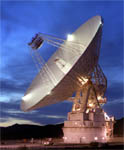

 Introduction to spacecraft commnications
Introduction to spacecraft commnications

 Introduction to spacecraft commnications
Introduction to spacecraft commnications

Binary digital data modulated onto the uplink is called command data. It is received by the spacecraft and either acted upon immediately or stored for future use or execution. Data modulated onto the downlink is called telemetry, and includes science data from the spacecraft's instruments and spacecraft health data from sensors within the various onboard subsystems.

P.I.G.S. communications The main starting point for communications ideas was the Pluto-Kuiper Express mission proposal.
Pluto-Kuiper Express Mission proposal
This mission differs in three main ways:
1) The craft will be in orbit around pluto, so transmissions will be limited to windows where the antenna can be pointed at earth.
2) The landers will have their own commuications system to relay data through the orbiter, then onto earth.
3) The amount of data to be transmitted is significantly larger than for Pluto Express. This means that as data rate and the power of transmission are directly proportional to the square of the HGA diameter see explanation below.
Orbiter-Earth Communications In order to allow the antenna to maintain Earth-point independent of the spacecraft's attitude, the telecommunications subsystem will include a steerable 2.6-metre high-gain parabolic antenna (HGA), which can be used for communications of 30 AUs and beyond. The HGA can also be used as a sunshade for the rest of the craft between 0.6AUs and 1AU where the proximity to the sun may over heat the spacecraft and damage systems. Also incuded in the communications subsystem are a redundant X-band solid state Power Amplifiers (SSPAs) and redundant Deep Space Transponder (SDSTs), the SDST will provide a modem-like interface to the rest of the spacecraft. A Low-Gain Antenna (LGA) will provide near-earth communications coverage.

This equipment is basically the same as proposed for the Pluto Express mission, all the technology is tried and tested.

Below are the UPLINK and DOWNLINK frequencies:
UPLINK - X-band, 7.1GHz
DOWNLINK - Ka-band, 32 GHz
X-band Wavelength Range 3.75 - 2.4 Frequency Range 8 -12
Ka-band Wavelength Range 2.4 - 0.75 Frequency Range 12 - 40
Due to the similarity in scientific instrument usage, we assume that the amount of data to be transmitted would be comparable to that transmitted by a Mars Express mission. This would mean that 77Mbits of data would need to be sent per earth day.
The orbiter will have a period of orbit of 10 minutes around Pluto, where transmission can be carried out for 4 minutes of that time, while the HGA can be pointed towards the earth.
The orbiter will have a period of 4 1/2 minutes around Charon, where transmission can be carried out for 2 minutes of that time.
This means that there would be 34560 seconds of transmission per day, with a data rate of 2.28 Kbit/sec. Using the same power and frequencies of the Pluto Express mission, which has a data rate of 340 bits/sec, the only way the increase in data rate is achieved is by increasing the proposed antenna diameter from 2 m as proposed in the Pluto Express mission, to 2.6 m.

DOWNLINK Data Rate - 2.28 Kbits/sec.
Downlink data rate assumes 50% HGA efficiency and a 70-m DSN antenna at 20 Degrees elevation angle and 90% weather.
UPLINK data rate assumes 34-m DSN transmitting at 20KW to the HGA. This represents the effective transmission rate for science commands.
Command and Data Handling subsystem When considerring a mass-storage system, we must take into account the effect on the mass and power requirements to the spacecraft. Solid-stage storage technology advances are making this less of a problem.
On-board Data storage = 2.1 GB
Consisting of two processors, 1 for engineering and 1 for science, 2 redundant blocks of 2Gbit DRAM using a "solid stage recorder".
The above systems will be interlinked so that due to a failure of one processor, the tasks can be carried out by the other/s.
The science demands on the communications systems and the storage system will be large. In order to minimalise the pressure on the storage and data systems, the science data will be collected in two phases; the first will collect and transmit data from the "Ice Maiden" probes, the second will store and transmit data from the orbiter. During the second phase, the collection of data will be further minimalised by a rota for which the instruments take turns to make their measurements.
In order to further maximise the data link, lossless compression will be used.
This material was produced by;
Helen Laird
2nd Year Undergradute
Physics with Space Science and Technology
University Of Leicester, England
Page maintained, licensed to, and copyrighted to N Mcdonald ©2000 Please DO NOT copy images, text, ideas, etc. -- Nathan Mcdonald, James Carpenter, Jenny Odell, Chris Smith , Helen Laird, Tim Boundy, Mark Fuller, Tom Charrett ©2000. For suppliers of images, please contact me.